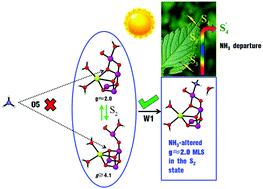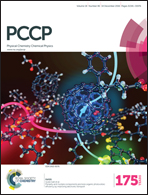How does ammonia bind to the oxygen-evolving complex in the S2 state of photosynthetic water oxidation? Theoretical support and implications for the W1 substitution mechanism†
Abstract
Ammonia as a water analogue can bind to the Mn4CaO5 cluster of the oxygen-evolving complex in concomitance with ligand substitution and underlying structural transformation. On account of current controversies of the binding site and the absence of the viewpoint of reactivity and mechanistic proofs, we have investigated three modes of NH3 binding based on our elaborations of the possible reaction mechanisms, in correspondence with experimental observation for the NH3-altered g ≈ 2.0 EPR multiline signal. Broken-symmetry density functional theory was employed to construct all the spin surfaces. As a result, we rule out the O5 substitution strategy owing to the impenetrable free energy barrier exceeding 30 kcal mol−1, and alternative routes to destroy the O5 bridge are also blocked. The W1 substitution mechanism is shown to be quite facile, with the barrier not above 11.4 kcal mol−1. For the Mn4 addition scheme, the ‘redox switch mechanism’ was not implemented by our model, and the effective ways found render 15–22 kcal mol−1 energetic disadvantage by contrast. Consequently, it is strongly in favor of the W1 substitution mechanism for its overwhelming superiority in reactivity, reaching a consensus with the new pulse EPR conclusion. Then, we point out that ammonia departure occurs in the S4′ state, with the O–O bonding but unreleased molecular O2. In the meantime, we propose two alternative channels for water binding in the S0′ state and expound the significance to substrate selectivity. Ultimately, implications for the mechanism of O–O bond formation are discussed and all the remaining options are listed for future explorations.


 Please wait while we load your content...
Please wait while we load your content...